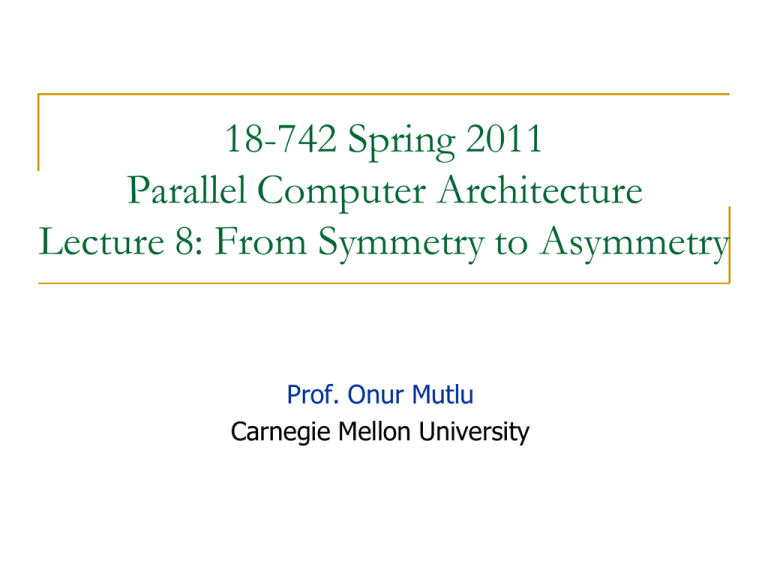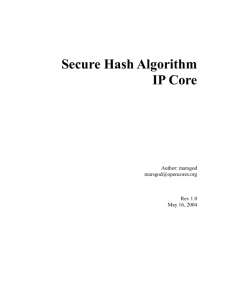18-742 Spring 2011 Parallel Computer Architecture Lecture 8: From Symmetry to Asymmetry
advertisement

18-742 Spring 2011 Parallel Computer Architecture Lecture 8: From Symmetry to Asymmetry Prof. Onur Mutlu Carnegie Mellon University Reviews Due Sunday (Feb 6) Tullsen et al., “Exploiting choice: instruction fetch and issue on an implementable simultaneous multithreading processor,” ISCA 1996. Spracklen and Abraham, “Chip Multithreading: Opportunities and Challenges,” HPCA Industrial Session, 2005. 2 Last Lecture Piranha CMP Evolution of Sun’s multi-core systems Wimpy to powerful Niagara to ROCK 3 More Powerful Cores in Sun ROCK Advantages + Higher single-thread performance (MLP + ILP) + Better cache miss tolerance Can reduce on-chip cache sizes Disadvantages - Bigger cores Fewer cores Lower parallel throughput (in terms of threads). How about each thread’s response time? - More complex than Niagara cores (but simpler than conventional out-of-order execution) Longer design time? 4 More Powerful Cores in Sun ROCK Chaudhry talk, Aug 2008. 5 More Powerful Cores in Sun ROCK Chaudhry et al., “Simultaneous Speculative Threading: A Novel Pipeline Architecture Implemented in Sun's ROCK Processor,” ISCA 2009 6 IBM POWER4 Tendler et al., “POWER4 system microarchitecture,” IBM J R&D, 2002. Another symmetric multi-core chip… But, fewer and more powerful cores 7 IBM POWER4 2 cores, out-of-order execution 100-entry instruction window in each core 8-wide instruction fetch, issue, execute Large, local+global hybrid branch predictor 1.5MB, 8-way L2 cache Aggressive stream based prefetching 8 IBM POWER5 Kalla et al., “IBM Power5 Chip: A Dual-Core Multithreaded Processor,” IEEE Micro 2004. 9 IBM POWER6 Le et al., “IBM POWER6 microarchitecture,” IBM J R&D, 2007. 2 cores, in order, high frequency (4.7 GHz) 8 wide fetch Simultaneous multithreading in each core Runahead execution in each core Similar to Sun ROCK 10 IBM POWER7 Kalla et al., “Power7: IBM’s Next-Generation Server Processor,” IEEE Micro 2010. 8 out-of-order cores, 4-way SMT in each core TurboCore mode Can turn off cores so that other cores can be run at higher frequency 11 Large vs. Small Cores Large Core Out-of-order Wide fetch e.g. 4-wide Deeper pipeline Aggressive branch predictor (e.g. hybrid) • Multiple functional units • Trace cache • Memory dependence speculation • • • • Small Core • • • • In-order Narrow Fetch e.g. 2-wide Shallow pipeline Simple branch predictor (e.g. Gshare) • Few functional units Large Cores are power inefficient: e.g., 2x performance for 4x area (power) 12 Large vs. Small Cores Grochowski et al., “Best of both Latency and Throughput,” ICCD 2004. 13 Tile-Large Approach Large core Large core Large core Large core “Tile-Large” Tile a few large cores IBM Power 5, AMD Barcelona, Intel Core2Quad, Intel Nehalem + High performance on single thread, serial code sections (2 units) - Low throughput on parallel program portions (8 units) 14 Tile-Small Approach Small core Small core Small core Small core Small core Small core Small core Small core Small core Small core Small core Small core Small core Small core Small core Small core “Tile-Small” Tile many small cores Sun Niagara, Intel Larrabee, Tilera TILE (tile ultra-small) + High throughput on the parallel part (16 units) - Low performance on the serial part, single thread (1 unit) 15 Can we get the best of both worlds? Tile Large + High performance on single thread, serial code sections (2 units) - Low throughput on parallel program portions (8 units) Tile Small + High throughput on the parallel part (16 units) - Low performance on the serial part, single thread (1 unit), reduced single-thread performance compared to existing single thread processors Idea: Have both large and small on the same chip Performance asymmetry 16 Asymmetric Chip Multiprocessor (ACMP) Large core Large core Large core Large core “Tile-Large” Small core Small core Small core Small core Small core Small core Small core Small core Small core Small core Small core Small core Small core Small core Small core Small core Small core Small core “Tile-Small” Small core Small core Small core Small core Small core Small core Small core Small core Small core Small core Large core ACMP Provide one large core and many small cores + Accelerate serial part using the large core (2 units) + Execute parallel part on all cores for high throughput (14 units) 17 Accelerating Serial Bottlenecks Single thread Large core Large core Small core Small core Small core Small core Small core Small core Small core Small core Small core Small core Small core Small core ACMP Approach 18 Performance vs. Parallelism Assumptions: 1. Small core takes an area budget of 1 and has performance of 1 2. Large core takes an area budget of 4 and has performance of 2 19 ACMP Performance vs. Parallelism Area-budget = 16 small cores Large core Large core Large core Large core Small Small Small Small core core core core Small Small Small Small core core core core Large core Small Small core core Small Small core core Small Small Small Small core core core core Small Small Small Small core core core core Small Small Small Small core core core core Small Small Small Small core core core core “Tile-Small” ACMP “Tile-Large” Large Cores 4 0 1 Small Cores 0 16 12 Serial Performance 2 1 2 2x4=8 1 x 16 = 16 1x2 + 1x12 = 14 Parallel Throughput 20 20 Some Analysis Hill and Marty, “Amdahl’s Law in the Multi-Core Era,” IEEE Computer 2008. Each Chip Bounded to N BCEs (Base Core Equivalents) One R-BCE Core leaves N-R BCEs Use N-R BCEs for N-R Base Cores Therefore, 1 + N - R Cores per Chip For an N = 16 BCE Chip: Symmetric: Four 4-BCE cores Asymmetric: One 4-BCE core & Twelve 1-BCE base cores 21 Amdahl’s Law Modified Serial Fraction 1-F same, so time = (1 – F) / Perf(R) Parallel Fraction F One core at rate Perf(R) N-R cores at rate 1 Parallel time = F / (Perf(R) + N - R) Therefore, w.r.t. one base core: 1 Asymmetric Speedup = 1-F Perf(R) F + Perf(R) + N - R 22 Asymmetric Multicore Chip, N = 256 BCEs 250 Asymmetric Speedup F=0.999 200 150 F=0.99 100 F=0.975 50 F=0.9 F=0.5 0 1 2 4 8 16 32 64 128 256 R BCEs Number of Cores = 1 (Enhanced) + 256 – R (Base) 23 Symmetric Multicore Chip, N = 256 BCEs Symmetric Speedup 250 200 F=0.999 150 100 F=0.99 F=0.975 50 F=0.9 F=0.5 0 1 2 4 8 Recall F=0.9, R=28, Cores=9, Speedup=26.7 16 32 64 128 256 R BCEs 24 Asymmetric Multicore Chip, N = 256 BCEs 250 Asymmetric Speedup F=0.999 F=0.99 R=41 (vs. 3) Cores=216 (vs. 85) Speedup=166 (vs. 80) 200 150 F=0.99 100 F=0.975 50 F=0.9 F=0.5 0 1 2 4 8 16 R BCEs 32 64 128 256 F=0.9 R=118 (vs. 28) Cores= 139 (vs. 9) Speedup=65.6 (vs. 26.7) Asymmetric multi-core provides better speedup than symmetric multi-core when N is large 25 Asymmetric vs. Symmetric Cores Advantages of Asymmetric + Can provide better performance when thread parallelism is limited + Can be more energy efficient + Schedule computation to the core type that can best execute it Disadvantages - Need to design more than one type of core. Always? - Scheduling becomes more complicated - What computation should be scheduled on the large core? - Who should decide? HW vs. SW? - Managing locality and load balancing can become difficult if threads move between cores (transparently to software) - Cores have different demands from shared resources 26 How to Achieve Asymmetry Static Type and power of cores fixed at design time Two approaches to design “faster cores”: High frequency Build a more complex, powerful core with entirely different uarch Is static asymmetry natural? (chip-wide variations in frequency) Dynamic Type and power of cores change dynamically Two approaches to dynamically create “faster cores”: Boost frequency dynamically (limited power budget) Combine small cores to enable a more complex, powerful core Is there a third, fourth, fifth approach? 27 Asymmetry via Boosting of Frequency Static Due to process variations, cores might have different frequency Simply hardwire/design cores to have different frequencies Dynamic Annavaram et al., “Mitigating Amdahl’s Law Through EPI Throttling,” ISCA 2005. Dynamic voltage and frequency scaling 28 EPI Throttling Goal: Minimize execution time of parallel programs while keeping power within a fixed budget For best scalar and throughput performance, vary energy expended per instruction (EPI) based on available parallelism P = EPI •IPS P = fixed power budget EPI = energy per instruction IPS = aggregate instructions retired per second Idea: For a fixed power budget Run sequential phases on high-EPI processor Run parallel phases on multiple low-EPI processors 29 EPI Throttling via DVFS DVFS: Dynamic voltage frequency scaling In phases of low thread parallelism Run a few cores at high supply voltage and high frequency In phases of high thread parallelism Run many cores at low supply voltage and low frequency 30 Possible EPI Throttling Techniques Grochowski et al., “Best of both Latency and Throughput,” ICCD 2004. 31 Boosting Frequency of a Small Core vs. Large Core Frequency boosting implemented on Intel Nehalem, IBM POWER7 Advantages of Boosting Frequency + Very simple to implement; no need to design a new core + Parallel throughput does not degrade when TLP is high + Preserves locality of boosted thread Disadvantages - Does not improve performance if thread is memory bound - Does not reduce Cycles per Instruction (remember the performance equation?) - Changing frequency/voltage can take longer than switching to a large core 32 EPI Throttling (Annavaram et al., ISCA’05) Static AMP Duty cycles set once prior to program run Parallel phases run on 3P/1.25GHz Sequential phases run on 1P/2GHz Affinity guarantees sequential on 1P and parallel on 3 Benchmarks that rapidly transition between sequential and parallel phases Dynamic AMP Duty cycle changes during program run Parallel phases run on all or a subset of four processors Sequential phases of execution on 1P/2GHz Benchmarks with long sequential and parallel phases 33 EPI Throttling (Annavaram et al., ISCA’05) Evaluation on Base SMP: 4 Base SMP: 4-way 2GHz Xeon, 2MB L3, 4GB Memory Hand-modified programs OMP threads set to 3 for static AMP Calls to set affinity in each thread for static AMP Calls to change duty cycle and to set affinity in dynamic AMP 34 EPI Throttling (Annavaram et al., ISCA’05) Frequency boosting AMP improves performance compared to 4-way SMP for many applications 35 EPI Throttling Why does Frequency Boosting (FB) AMP not always improve performance? Loss of throughput in static AMP (only 3 processors in parallel portion) Rapid transitions between serial and parallel phases Is this really the best way of using FB-AMP? Data/thread migration and throttling overhead Boosting frequency does not help memory-bound phases 36 Review So Far Symmetric Multicore Evolution of Sun’s and IBM’s Multicore systems and design choices Niagara, Niagara 2, ROCK IBM POWERx Asymmetric multicore Motivation Functional vs. Performance Asymmetry Static vs. Dynamic Asymmetry EPI Throttling 37 Design Tradeoffs in ACMP (I) Hardware Design Effort vs. Programmer Effort - ACMP requires more design effort + Performance becomes less dependent on length of the serial part + Can reduce programmer effort: Serial portions are not as bad for performance with ACMP Migration Overhead vs. Accelerated Serial Bottleneck + Performance gain from faster execution of serial portion - Performance loss when architectural state is migrated/switched in when the master changes Can be alleviated with multithreading and hidden by long serial portion - Serial portion incurs cache misses when it needs data generated by the parallel portion - Parallel portion incurs cache misses when it needs data generated by the serial portion 38 Design Tradeoffs in ACMP (II) Fewer threads vs. accelerated serial bottleneck + Performance gain from accelerated serial portion - Performance loss due to unavailability of L threads in parallel portion This need not be the case Large core can implement Multithreading to improve parallel throughput As the number of cores (threads) on chip increases, fractional loss in parallel performance decreases 39 Uses of Asymmetry So far: Improvement in serial performance (sequential bottleneck) What else can we do with asymmetry? Energy reduction? Energy/performance tradeoff? Improvement in parallel portion? 40





